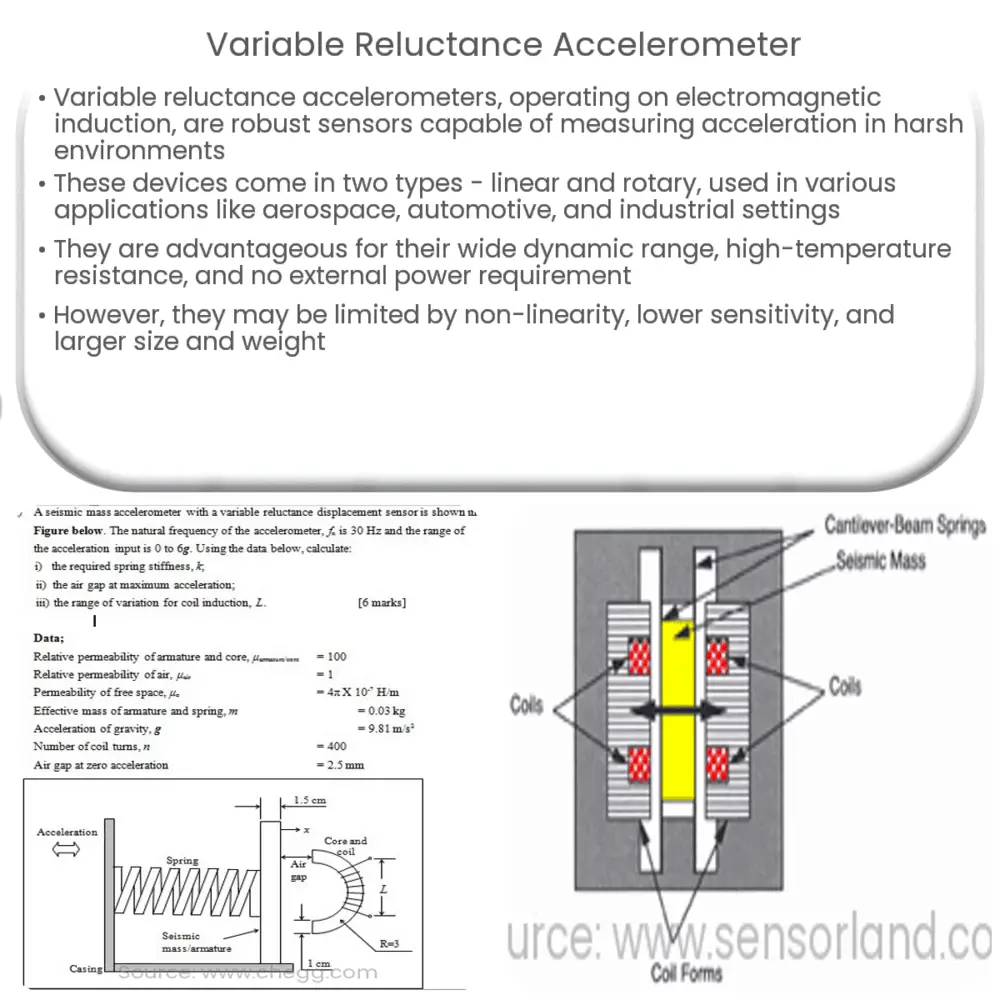Variable reluctance accelerometers are rugged sensors that measure acceleration based on electromagnetic induction, ideal for harsh environments.

Variable Reluctance Accelerometer: Principles and Applications
Introduction
The variable reluctance accelerometer is a type of sensor that measures acceleration, particularly in the field of vibration analysis and testing. It is known for its ruggedness, reliability, and ability to perform in harsh environments. In this article, we will explore the principles behind the variable reluctance accelerometer, its working mechanism, and its various applications across industries.
Principle of Operation
Variable reluctance accelerometers operate based on the principle of electromagnetic induction. They consist of a magnetic core, a coil, and a seismic mass. The seismic mass is attached to a spring and is suspended within the magnetic core, which is surrounded by the coil. As the accelerometer experiences acceleration, the seismic mass moves, causing a change in the magnetic field within the core. This change in magnetic field induces an electrical voltage in the coil, which is proportional to the applied acceleration.
One of the main advantages of variable reluctance accelerometers is their ability to withstand extreme temperatures and harsh environments. They do not require external power sources, making them suitable for use in applications with limited access to power. Additionally, they have a wide dynamic range and can measure both low-frequency and high-frequency vibrations.
Types of Variable Reluctance Accelerometers
There are two main types of variable reluctance accelerometers: linear and rotary. Linear variable reluctance accelerometers measure linear acceleration along a single axis, while rotary variable reluctance accelerometers measure angular acceleration.
Linear variable reluctance accelerometers are commonly used in applications such as automotive testing, aerospace, and structural health monitoring. Rotary variable reluctance accelerometers, on the other hand, are often employed in applications involving rotating machinery, such as turbines, motors, and gearboxes, to measure and analyze vibrations caused by imbalances, misalignments, or bearing faults.
Applications
Variable reluctance accelerometers are widely used across various industries for their robustness, reliability, and ability to operate in harsh environments. Some of the most common applications include:
- Aerospace: Monitoring vibrations and structural health in aircraft and spacecraft, ensuring optimal performance and safety.
- Automotive: Testing vehicle components, such as engines, transmissions, and suspension systems, for performance and durability.
- Industrial: Assessing the health and performance of rotating machinery, such as motors, turbines, and gearboxes, to detect and prevent potential failures.
- Structural health monitoring: Measuring vibrations in buildings, bridges, and other structures to assess their integrity and detect potential issues.
- Seismic monitoring: Recording ground motion caused by earthquakes, volcanic activity, or human-induced events, such as mining or construction.
Advantages of Variable Reluctance Accelerometers
Variable reluctance accelerometers offer several advantages over other types of accelerometers, such as capacitive and piezoelectric sensors. These advantages include:
- Wide dynamic range: Capable of measuring both low-frequency and high-frequency vibrations, making them suitable for a variety of applications.
- High temperature resistance: Able to withstand extreme temperatures, making them ideal for use in harsh environments, such as aerospace and industrial settings.
- No external power required: Their self-generating nature eliminates the need for an external power source, which simplifies installation and reduces maintenance requirements.
- Ruggedness and reliability: Due to their robust design, variable reluctance accelerometers are less susceptible to mechanical damage and can withstand shock and vibration better than other types of sensors.
Limitations of Variable Reluctance Accelerometers
Despite their numerous advantages, variable reluctance accelerometers also have some limitations, which include:
- Non-linearity: The output voltage is not always perfectly linear with respect to the applied acceleration, especially at high frequencies or large amplitudes.
- Lower sensitivity: Compared to other accelerometer technologies, such as piezoelectric sensors, variable reluctance accelerometers generally have lower sensitivity. This may limit their effectiveness in applications requiring very precise measurements.
- Size and weight: Due to their robust construction, these sensors tend to be larger and heavier than alternative accelerometer technologies, which might be a drawback in some applications where space and weight are critical factors.
Conclusion
Variable reluctance accelerometers are a versatile and robust option for measuring acceleration in a wide range of applications. Their ability to withstand harsh environments, wide dynamic range, and self-generating nature make them a popular choice for aerospace, automotive, industrial, and structural health monitoring applications. While they may not be suitable for all situations due to their limitations, they remain a reliable and effective solution for many vibration and acceleration measurement needs.
References
- Everstine, G. C. (1986). A user’s guide to accelerometers. Shock and Vibration Information Analysis Center, 1-49.
- Mitra, M., & Gopalakrishnan, S. (2006). A review of sensing and signal processing for structural health monitoring of bridges. Advances in Structural Engineering, 9(5), 595-609.
- Titterton, D. H., & Weston, J. L. (2004). Strapdown Inertial Navigation Technology. Institution of Electrical Engineers.

